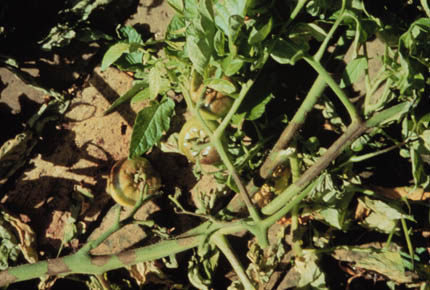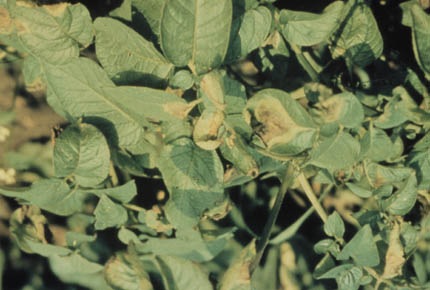Late blight
Scientific name:
Phytophthora infestans
Causal organism: Fungus
Common names: Late blight of potato, Potato blight, Late blight of tomato, Tomato blight
Host plants
Tomato and potato are the primary hosts; eggplant and pepper are secondary hosts
Affected plant stages
Seedling, vegetative, and reproductive stages
Affected plant parts
Leaves, stem, fruits, and tubers
Symptoms
Newly infected leaves have dark-green watersoaked small lesions (spots), and as the lesions grow, they appear as brown spots, with each spot surrounded by a yellow green margin. A closer look at the leaf margin will show where the fungus is most active and how it spreads on the leaf tissues. There is a halo (ring) of white spore
producing structures that is found in the margin of the advancing lesion on the underside of the leaf. As the infection spreads, more brown spots appear causing the whole plants to blacken and die. A plant that is severely infected by late blight has a distinctive odor as a result of the rapid breakdown of the leaf tissues.
 Late blight of tomato
Late blight of tomato
Photo: Beth Jarvis, University of Minnesota
On tomato, an infected leaf has large oily lesions formed on its upper surface that dry towards the center with corresponding downy white coatings found on its underside. The parts of the veins passing through these lesions turn brownish. The infected stem has also brown to black irregular spots that destroy the emergence of new shoots at various growing points. Infested young fruit has brown bumps with
lesions that are large, irregular, and greenish-brown patches with a greasy rough appearance. Infected fruits never reach maturity.
 Late blight of potato
Late blight of potato
Photo courtesy of University of Minnesota
On potato, a newly infected leaf has small, light to dark-green and irregular to circular-shaped watersoaked spots. The lesions usually appear first on the lower leaves and continue to grow near the leaf tips or edges where moisture is retained the longest. During cool and moist weather, the lesions expand rapidly into large, greasy dark-brown or black spots. As they coalesce (meet), the entire leaves become blighted and die within a few days. Infection can spread down to the petioles and stems of the plant causing it to wither and die.
An infected potato tuber has irregularly-shaped and slightly-depressed
brown to purplish lesions on the skin surface. Underneath the skin, a tan to reddish-brown, dry, and granular rot occurs that extends its infection to the center of the tuber.
Conditions that favor development
- Infected seeds and tubers that are used as planting materials; diseased planting materials
- A cool and warm temperature that is not less than 10ºC and a relative humidity of over 75% that lasts for 2 consecutive days is the most ideal time for the fungus to reproduce (Deacon, 2003)
- Infected fruits and tubers left in the field
- Volunteer plants that grow from previously infected parent plants
Prevention and control
- If possible buy a potato variety that is resistant to the disease. However, there is no tomato variety that is resistant to late blight.
- Plant only diseased-free seed
and tubers.
One method of planting diseased-free potatoes is to observe the following practices (Song, 2001).
Take the potato tubers out in the field or keep in a warm place for about 15 - 20 days before planting,
Let them sprout at a temperature of 15 - 20ºC for 10 - 15 days, Diseased potato tubers will rot in high temperatures,
Remove the rotten ones and dispose of them properly, and
Properly select the healthy sprouted potatoes as planting materials.
- Pre-germinate potatoes 14 days before planting them in the field to enhance seedling development and to minimize the damage by the disease (Wagner, 2004).
- Do not plant potato near tomato or other solanaceous crops field, or vice versa (Wagner, 2004).
- Practice proper field sanitation. Properly remove culled potatoes or tomatoes and destroy all volunteer potato/tomato plants.
- Proper plant
spacing is important to have proper aeration among the plants and proper sunlight penetration. Ask for assistance from your local agriculturist office.
- Sow tubers in holes more than 15 cm deep to protect tubers from easy infection (Song, 2001)
- Hilling up the plant rows will also reduce tuber infestation. Good soil coverage provides better protection for the potato tubers.
- At the beginning of the harvest where late blight is confirmed, harvest potato when the vines are completely dead because the fungi-causing blight will not survive in dead vegetation.
- Dry tubers and remove infected ones before storing to reduce additional losses from soft rot diseases.
- Listen to weather forecasts on the possible late blight outbreaks or ask for updates from your local agriculturists. The Temperature-humidity rule is one of the methods used to forecast the late blight epidemic (Deacon, 2003).
- Copper spray (Wagner, 2004).


